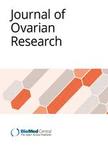版权所有:内蒙古大学图书馆 技术提供:维普资讯• 智图
内蒙古自治区呼和浩特市赛罕区大学西街235号 邮编: 010021

作者机构:China Med Univ Ctr Reprod Med Shengjing Hosp 36 SanHao St Shenyang 110004 Peoples R China China Med Univ Dept Neurol First Hosp Shenyang 110002 Peoples R China China Med Univ Educ Ctr Clin Skills Practice Shenyang 110122 Peoples R China Key Lab Reprod Dysfunct Dis & Fertil Remodeling L Shenyang 110122 Peoples R China
出 版 物:《JOURNAL OF OVARIAN RESEARCH》 (卵巢癌研究杂志)
年 卷 期:2022年第15卷第1期
页 面:1-13页
核心收录:
学科分类:0710[理学-生物学] 1002[医学-临床医学] 100214[医学-肿瘤学] 10[医学]
基 金:National Natural Science Foundation of China LiaoNing Revitalization Talents Program [XLYC1907071] Fok Ying Tung Education Foundation Key Research and Development Program of Liaoning Province Outstanding Scientific Fund of Shengjing Hospital
主 题:Polycystic ovary syndrome Biomarkers Immune infiltration Machine learning algorithm CIBERSORT
摘 要:Background In this study, we aimed to identify novel biomarkers for polycystic ovary syndrome (PCOS) and analyze their potential roles in immune infiltration during PCOS pathogenesis. Methods Five datasets, namely GSE137684, GSE80432, GSE114419, GSE138518, and GSE155489, were obtained from the Gene Expression Omnibus database. Differentially expressed genes (DEGs) were selected from the train datasets. The least absolute shrinkage and selection operator logistic regression model and support vector machine-recursive feature elimination algorithm were combined to screen potential biomarkers. The test datasets validated the expression levels of these biomarkers, and the area under the curve (AUC) was calculated to analyze their diagnostic value. Quantitative real-time PCR was conducted to verify biomarkers expression in clinical samples. CIBERSORT was used to assess differential immune infiltration, and the correlations of biomarkers with infiltrating immune cells were evaluated. Results Herein, 1265 DEGs were identified between PCOS and control groups. The gene sets related to immune response and adaptive immune response were differentially activated in PCOS. The two diagnostic biomarkers of PCOS identified by us were HD domain containing 3 (HDDC3) and syndecan 2 (SDC2;AUC, 0.918 and 0.816, respectively). The validation of hub biomarkers in clinical samples using RT-qPCR was consistent with bioinformatics results. Immune infiltration analysis indicated that decreased activated mast cells (P = 0.033) and increased eosinophils (P = 0.040) may be a part of the pathogenesis of PCOS. HDDC3 was positively correlated with T regulatory cells (P = 0.0064), activated mast cells (P = 0.014), and monocytes (P = 0.024) but negatively correlated with activated memory CD4 T cells (P = 0.016) in PCOS. In addition, SDC2 was positively correlated with activated mast cells (P = 0.0021), plasma cells (P = 0.0051), and M2 macrophages (P = 0.038) but negatively correlated with eosinophils